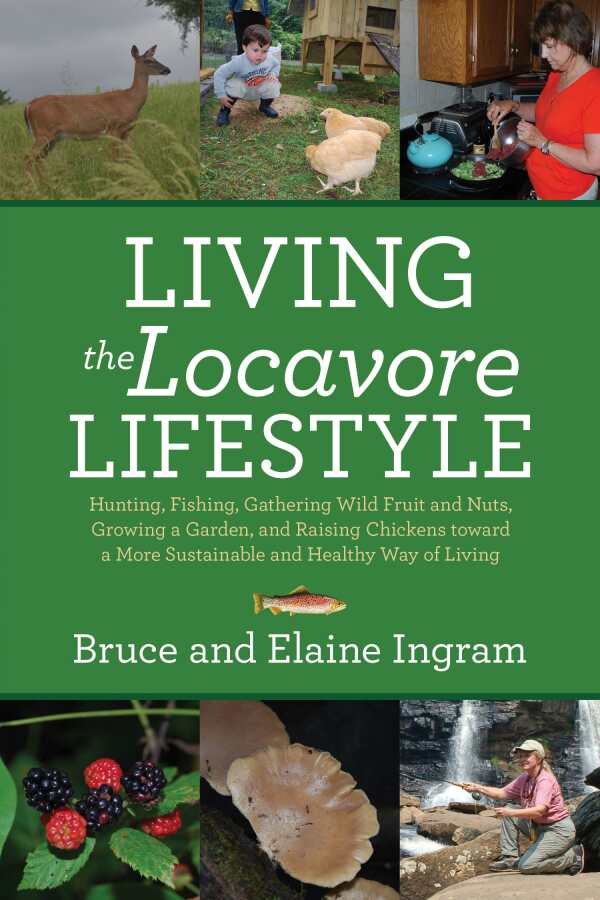Living the Locavore Lifestyle
Hunting, Fishing, Gathering Wild Fruit and Nuts, Growing a Garden, and Raising Chickens toward a More Sustainable and Healthy Way of Living
This collection of practical advice will appeal to the widening circle of readers who want to be more active in raising, foraging, and hunting their own foods.
Living the Locavore Lifestyle, by Bruce and Elaine Ingram, provides a good survey of the many ways the couple puts food on their table. While their approach is tailored to their rural Virginia locale and personal tastes, there is a wealth of advice for anyone who is looking to be more self-reliant in stocking the freshest, most pesticide-free, and most nutritious foods for their pantry.
These pages stress that a locavore lifestyle, which involves lots of activity spent outdoors, has the additional benefits of exercise, fresh air, and communion with the natural world. The first half of the book is devoted to detailed information about hunting and fishing, with the Ingrams recommending the seeking out of hunting mentors and information from outdoors and conservation groups as a good starting point. The book further outlines ways to field-dress, butcher, and cook wild game from snout to tail, with lots of suggestions about organ meat for the culinarily adventurous. Many tasty-sounding recipes stud these pages, as with the rest of the chapters about foraging wild foods, growing fruit trees and vegetables, and the authors’ ongoing experiments in raising egg-laying chickens.
The Ingrams write with enthusiasm and authority. They relate their successes as well as their setbacks, exhibiting passion for continuing to learn more about how to improve their food-gathering techniques. The text is personalized, with many anecdotes about being outdoors with their children and grandchildren and passing on their skills and love of nature. While avoiding outright disdain, there is a certain impatience for people who rely on the supermarket for all of their food—“anyone with a bucket can find places to gather nature’s bounty”—and Bruce seems particularly irritated when he relates the tale of a young man who came out hunting with him one morning and was winded atop a minor hill after downing “some sort of greasy, fried concoction” for breakfast.
As tough a woodsman as Bruce is, he shares his tender streak for his wife, a breast cancer survivor, in many asides about how much he appreciates her cooking, fly fishing, and companionship. Such sections burst with pride and add an endearing quality to the otherwise factual prose, as when he relates how she made him “the most magnificent present I have ever received—a fly tied from a turkey feather that came from a bird that I had called in and killed.”
Compared to the wealth of information presented in the hunting and fishing sections, some of the later chapters are a bit scanty. For example, the chapter on growing a backyard garden is only three pages long, and that includes a large photograph of a tomato plant.
Numerous black-and-white photographs illustrate the book, but while the shots taken outdoors reproduce well, the indoor photos and shots of cooked dishes are overly dark and grainy, or are of subjects that don’t really add much instructional value to the text. The color photographs on the covers are much more vibrant and sharp.
Bruce and Elaine Ingram’s prescriptions for Living the Locavore Lifestyle are a good introduction to supermarket alternatives for stocking the home pantry. This collection of practical advice will appeal to the widening circle of readers who want to be more active in raising, foraging, and hunting their own foods for a variety of health and environmental reasons.
Reviewed by
Rachel Jagareski
Disclosure: This article is not an endorsement, but a review. The publisher of this book provided free copies of the book and paid a small fee to have their book reviewed by a professional reviewer. Foreword Reviews and Clarion Reviews make no guarantee that the publisher will receive a positive review. Foreword Magazine, Inc. is disclosing this in accordance with the Federal Trade Commission’s 16 CFR, Part 255.

